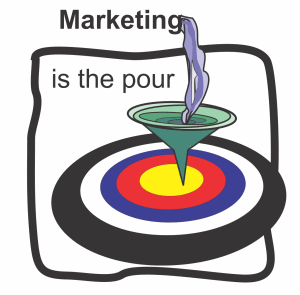 “Big business or small business marketing is not a funnel,” I ranted as we took our seats.
“Big business or small business marketing is not a funnel,” I ranted as we took our seats.
Kate our sales doyen said, “The whole thing of getting people to buy has been called the sales funnel for years, why are you arguing with the obvious?”
I said, “Because it isn’t.”
Rob, the rotund branding Buddha, asked, “What isn’t?”
“Marketing is not the funnel. It is the pour, I said.
Five voices said in harmony, “The pour?”
“I think about Small Business Marketing all the time. One of the confusions that has occurred as we’ve seen the world move toward digital marketing is the integration of automated marketing and sales force contact management systems and what are now called contact relationship management systems. Marketing, Sales and Customer Relations are all being knotted up in a single system so the boundaries keep getting confused,” I said.
“I thought you liked integrated systems,” said Rick, our go to guy for direct marketing.
“I do,” I said, “but when sales expects marketing to hand them leads so qualified a rookie could close them something is wrong with the system and when sales pushes the maintenance of a relationship off to customer service…”
Kate pounced saying, “What is your problem? Sales is responsible for hitting higher quotas every year. We have to make sure we’re closing all the time. Now you have the tools to do the nurturing you need to do to get us good leads. What is your problem?”
“My problem,” I said, “is the same one that marketing departments and agencies and consultants all have. The expectations of corporate America have shifted to make us responsible for the funnel instead of the pour. Before, our job was to pour as many folks as possible into the sales funnel. We were always pushed to qualify them as potential customers. But sales had to close them”
“Thas right,” said Rob. All our ads built awareness of the brand, gave folks reasons to prefer the brand and even included offers for more information or free trials. Our job was to pour people into the funnel. Sales had to nurture them.”
“Bubba, I couldn’t agree more,” said Rick. My business is a combination of marketing and sales so we have to understand objections and stalls and all the stuff that a sales person goes through nose to nose with a prospect because we have to deal with it in print and video and you name it. Our job was to pour people into the funnel and move them as far down it as possible either getting the sale or handing off to a sales person.”
Gail said, “But things have changed. Marketing is expected to pour people into the funnel and then do all the information provision, all the nurturing, all the Q & A, all the funnel fact analysis, all the digital body language observation and in some cases even take the orders on line.”
Chris said, “But that is not all bad. My Marketing staff and the Sales staff sit side by side. There is great feedback both directions. We try to be professional about it. Marketing knows that our primary job is to pour as many people as possible into the funnel. And we know that we can help move people down the funnel but sales ultimately is responsible for changing contacts into contracts.
Thing is, we used to fight about the materials and presentations needed and sales would go zooming around completely off the Value Proposition.
Not anymore.
By working together we close faster, easier and more profitably.
Marketing’s job is the pour and to lubricate the customer’s journey down the funnel.”
“I guess I can buy into helping grease the funnel,” I said, as long as marketing is still the pour.”
Jerry Fletcher is focused on making the techniques of enterprise level marketing available to small businesses. His consulting website is www.JerryFletcher.com
Jerry speaks professionally on networking, marketing and Contact Relationship Magic across the Americas. His speaking website is: www.NetworkingNinja.com



